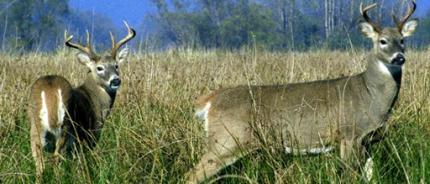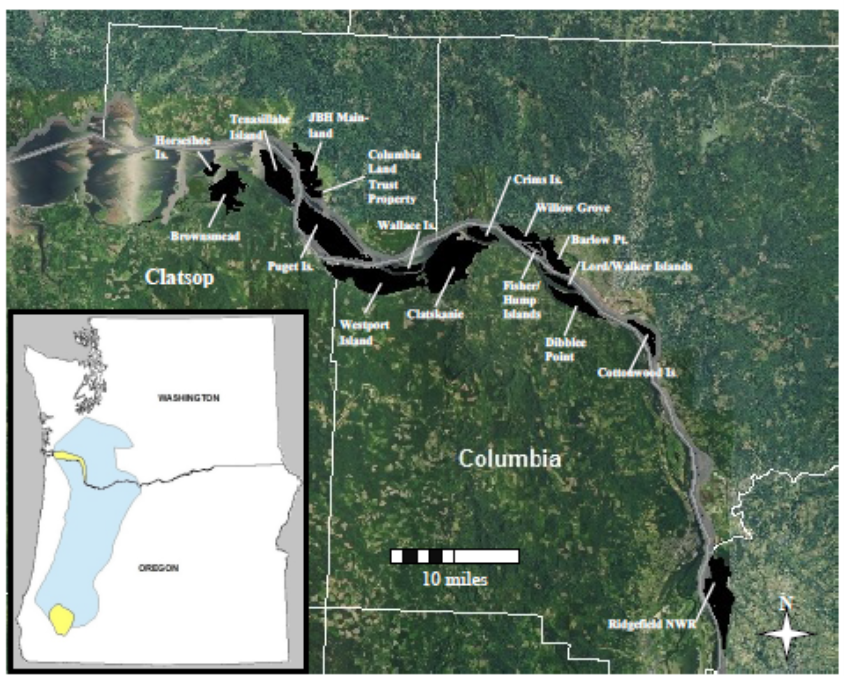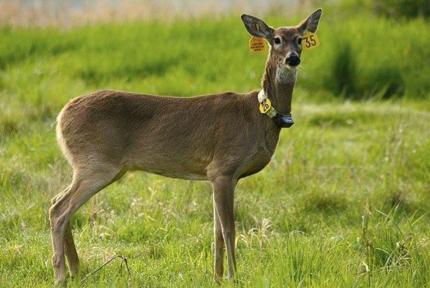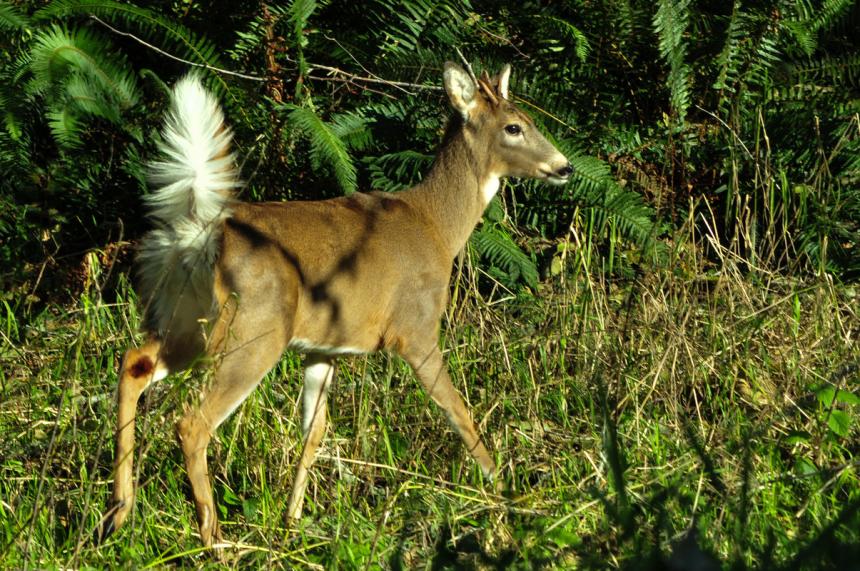High
The Columbian white-tailed deer is listed as federally threatened along the lower Columbia River (Clark, Cowlitz, and Wahkiakum counties in Washington, and Clatsop and Columbia counties in Oregon). As of March 2020, an estimate of 1,200 Columbian white-tailed deer inhabit this area along the lower Columbia River.
This westernmost subspecies of white-tailed deer exists in small, isolated populations, rendering it vulnerable to such factors as disease and stochastic events. Continued habitat degradation will impede recovery by further fragmenting their existing habitat. This species also will be greatly affected by climate change due to sea level rise that will reduce the tidally influenced island and lowland habitats that the deer inhabit.
Description and Range
Physical description
The Columbian white-tailed deer is the westernmost subspecies of white-tailed deer and is considerably smaller than other white-tailed deer in northern latitudes. They are generally distinguishable from black-tailed deer (Odocoileus hemionus) by a longer brown (rather than black) tail, white eye ring, smaller metatarsal gland, and antler tines that arise from the main beam. Generally, this species displays a red-brown color in summer and a thicker gray-colored coat in the fall, with distinct white eye rings and a white nose ring just above their nose. Learn more about how to distinguish between Columbian white-tailed deer and black-tailed deer in this short video.
Ecology and life history
Columbian white-tailed deer historically preferred upland prairie edge and deciduous woodland habitat types below the Douglas-fir (Pseudotsuga menziesii) zone. Much of this upland habitat has been lost to past and modern-day land use activities (such as agriculture and urbanization). This has relegated them to inhabit fragmented and suboptimal pockets of lowland and floodplain habitat, which is much wetter and flood-prone than their historical habitat.

Columbian white-tailed deer have somewhat adapted to these lower elevation floodplains. Within these areas they have an affinity for more open deciduous forested habitat. They also use savanna, park-like forest, and open grasslands as habitat.
The diet of this deer consists of grasses, forbs, and browse.
Breeding season takes place from mid-September until late-February. The rut (a time period of sexual activity in males) begins the first week of November and reaches its peak by about the second week of November. .Adult females give birth to two fawns per year on average. Peak fawning occurs around June, and fawns remain with their mother until just before the next fawning season when their mothers depart to give birth to the next generation.
Geographic range
Columbian white-tailed deer is endemic to the Pacific Northwest and is the westernmost subspecies of white-tailed deer. The Columbia River population is believed to have originally occurred in both lowland riparian and upland prairie-deciduous forested habitat in the Columbia and Willamette river valleys of Washington and Oregon. The range of the subspecies also extended along a contiguous area into Oregon as far south as Grants Pass.
The current range has been reduced to two isolated populations, one of which is confined to Douglas County, Oregon. The other population is restricted to islands and the adjacent mainland along the lower Columbia River in Clark, Cowlitz, and Wahkiakum counties in Washington, and Clatsop, Columbia, and Multnomah counties in Oregon.
The aerial imagery map shows locations (names in white) occupied by Columbian white-tailed deer along the lower Columbia River; the inset graphic shows the species’ likely historic range in blue and current range in yellow in southwest Washington and western Oregon.

For a map reflecting this species’ conservation status and other species’ information, check out NatureServe Explorer.
Climate vulnerability
Sensitivity to climate change
High
The riparian habitats, bottomlands, and tidelands that Columbian white-tailed deer occupy are vulnerable to periodic major flooding events. Climate change projections in the lower Columbia River show that its effects on flood frequency and intensity could be significant. Climate change forecasts show sea levels that could rise by almost a foot by 2050. This would almost certainly lead to severe recurring floods in tidally influenced parts of the Columbia River, which in time could undermine the integrity of dikes. There is significant risk to Columbian white-tailed deer, particularly from an increased probability of habitat loss in low-lying riparian areas in the face of sea level rise. Sea level rise could also increase groundwater tables, which could influence forage composition and availability.
Exposure to climate change
Moderate-
High
- Increased flooding
- Sea level rise
- Increased extreme precipitation events
- Increased invasive species
- Increased disease outbreaks
Regulations
Rules and seasons
Columbian white-tailed deer found in southwest Washington are a protected species and are not legal to hunt.
White-tailed deer found east of the Cascade crest are managed as game animals; for current rules, be sure to check current big game hunting regulations.
Conservation
Conservation Threats and Actions Needed
- Stabilize and expand deer populations
- Threat: Populations are small and isolated due to habitat loss and fragmentation.
- Actions Needed: Conduct translocations and population augmentations; and continue annual aerial population surveys and ground monitoring of doe-to-fawn ratios to estimate and track deer numbers.
- Habitat loss and degradation
- Threat: Loss of deciduous forested habitat.
- Actions Needed: Re-establish deciduous forested habitats (including expanding riparian vegetation, tree and shrub planting, water manipulation) available within the occupied range, and identify areas to restore deciduous forest outside the occupied range where feasible. Acquire and protect habitat. Improve habitat connectivity. Improve forage and browse availability (since body condition is related to survival and reproductive health).
- Disease response and mitigation
- Threat: Negative effects of infectious and communicable diseases.
- Action Needed: Collaborate with partners to ensure that Columbian white-tailed deer are included in emerging disease response plans.
- Climate change effects
- Threat: Loss of lowland habitat from more frequent and intense flooding.
- Actions Needed: Build and maintain water control structures on refuges, as needed, to manage water levels in sloughs and marshes. Consider construction of high-water refugia. Increase availability of and connectivity to suitable upland habitat.
- Resource information collection needs
- Threat: Suitable natural habitat is unstable and limited. There is a need to search for suitable habitat beyond what is currently occupied.
- Action Needed: Identify high quality upland habitat in areas that might support deer populations regardless of land ownership.
- Threat: Hybridization with black-tailed deer.
- Action Needed: Genetic sampling during future translocations to evaluate hybridization.
- Invasive and other problematic species
- Threat: Coyote predation causes high fawn mortality and has a disproportionate effect on small subpopulations.
- Action Needed: Continue efforts to control coyotes when needed.
- Threat: Invasive plants erode utility of habitats.
- Action Needed: Implement efforts to control invasive plants.
See the Climate vulnerability section for more information about the threats posed by climate change to this species.
Our Conservation Efforts
WDFW partners with federal and other state agencies, tribal government, conservation organizations and volunteers on various projects aimed at recovering Columbian white-tailed deer in their Columbia River range.
Partners have carried out activities to help bolster this population, including habitat protection and restoration, predator control, and translocating deer to enhance their numbers and expand their geographic range.

Recent research and conservation activities to benefit Columbian white-tailed deer have included:
- Translocation of Columbian white-tailed deer to expand deer to a new population on the Columbia Stock Ranch near Deer Island. Prior to this work, the site has undergone habitat enhancements including the planting of native trees and forage as well as the removal of non-native Himalayan blackberry. The site is owned by the Columbia Land Trust. The restoration is occurring in four phases and is expected to be completed by 2023.
- The Washington Department of Fish and Wildlife in partnership with Oregon Department of Fish and Wildlife (ODFW), U.S. Fish and Wildlife Service (USFWS), and the Cowlitz Tribe completed a Population-Habitat Viability Analysis (and a Population Viability Analysis) in 2020. This analysis (and recommendations therein) will shed light on several issues important to this species conservation and recovery.
- Recent deer counts have demonstrated that the translocation of deer from Julia Butler Hansen to Ridgefield National Wildlife Refuges appears to have been a success. In 2013 and 2014, 58 deer were translocated to the Ridgefield NWR. This population has not only grown to nearly 200 deer as of March 2020, but these deer have also moved across the river to populate areas in and around Sauvie Island in Oregon.
- The Columbian White-tailed Deer Habitat Connectivity Analysis was published the Washington Department of Transportation in October 2016. Technical support for this work came from WDFW, the Cowlitz Indian Tribe, USFWS, ODFW, and the Oregon Department of Transportation.
Resources
References
USFWS. 2015. Columbian White-tailed Deer Recovery
USFWS. 2014. Final environmental assessment: proposed translocation of Columbian white-tailed deer from Puget Island to Ridgefield National Wildlife Refuge and Julia Butler Hansen Refuge. U.S. Fish and Wildlife Service, Cathlamet, Washington.
USFWS. 2013. Columbia River distinct population segment of the Columbian white-tailed deer (Odocoileus virginianus leucurus). Five-year review: summary and evaluation. U.S. Fish and Wildlife Service, Lacey, Washington.
WDFW publications
PHS Program
Status Reports
- Washington State Periodic Status Review for the Columbian White-tailed Deer (2023)
- Washington State Periodic Status Review for the Columbian White-tailed Deer (2016)
Other resources
- U.S. Fish and Wildlife Service – Columbian White-tailed Deer Species Profile
- U.S. Fish and Wildlife Service – Julia Butler Hansen Refuge for the Columbian White-tailed Deer
- U.S. Fish and Wildlife Service – Julia Butler Hansen Refuge for the Columbian White-tailed Deer: Mammals - Columbian White-tailed Deer
- U.S. Dept. of Energy, BPA /U.S. Dept. of Interior, USFWS - Columbian White-tailed Deer Translocation from Tenasillahe Island to Columbia Stock Ranch Draft Environmental Assessment (2018) (PDF)
- WDFW & IUCN/SSC Conservation Planning Specialist Group - Columbian White-Tailed Deer Population and Habitat Viability Assessment - Workshop Report (2018) (PDF)
- Washington Dept. of Transportation: Columbian white-tailed deer habitat connectivity model - An outgrowth of the Kelso to Martin’s Bluff rail project - PowerPoint (McAllister 2016) (PDF)



